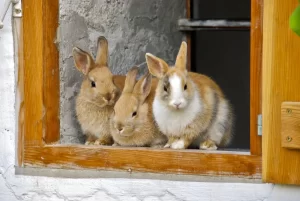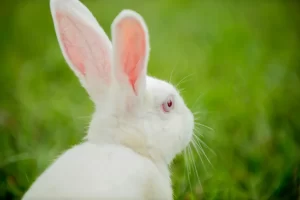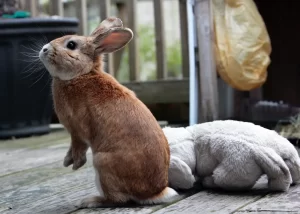In the enchanting world of rabbits, silence is not always golden. These fluffy creatures have a secret language of sounds that they use to communicate their emotions and intentions. From soft clucks of contentment to powerful thumps of warning, each sound holds a hidden message.
In this article, we will unravel the meaning behind 14 different sounds that rabbits make. So, if you’ve ever wondered what your furry friend is trying to say, join us as we dive into the captivating world of rabbit sounds and their meanings.
In This Article
- 1 Key Takeaways
- 2 Clucking: Soft Clucking Sound When Rabbits Enjoy Their Meal
- 3 Thumping: Back Foot Thumping as a Natural Reaction to a Threat or to Communicate
- 4 Purring: Gentle Teeth Grinding When Rabbits Are Calm and Content
- 5 Oinking or Honking: Soft Sound Indicating Happiness and Excitement
- 6 Sneezing: Common When Nasal Passages Are Irritated by External Irritants or Infections
- 7 Whimpering or Whining: Indicates Fear or Being Scared, Needing Space to Feel Safe
- 8 Grunting: Sign of Annoyance, Feeling Threatened, or Protecting Territory
- 9 Teeth Grinding: Loud and Intense Grinding Indicating Discomfort or Pain
- 10 Growling: Intense Version of Grunting, Expressing Anger or Stress
- 11 Screaming: Very Loud and High-Pitched Scream When Rabbits Are Extremely Scared or in Pain
- 12 Snoring: Can Occur Due to Sleeping Position, Excess Weight, Allergies, Dental Issues, or Flat Noses
- 13 Soft Noises While Asleep:
- 14 Hissing: Rare Sound Used to Show Aggression or Ward off Threats
- 15 Notable Considerations and Comments
- 16 Conclusion
Key Takeaways
- Rabbits communicate their feelings through sounds, with different sounds indicating different emotions and needs.
- Some common rabbit sounds include clucking, thumping, purring, oinking or honking, and sneezing.
- Uncommon rabbit sounds include snoring, soft noises while asleep, and hissing.
- It is important to pay attention to sudden changes in a rabbit’s snoring patterns or sounds, as it may require a visit to the vet.
Clucking: Soft Clucking Sound When Rabbits Enjoy Their Meal
During mealtime, rabbits often show their enjoyment by making a soft clucking sound. This gentle clucking is a way for rabbits to communicate their contentment and pleasure while eating. It’s a positive sound that indicates satisfaction and happiness.
Rabbits can communicate with humans through various sounds, and the clucking sound is one of them. It’s their way of expressing gratitude and enjoyment for the food provided by their human companions.
However, when it comes to communicating with other animals, rabbits primarily rely on body language and scent marking rather than vocalizations. They use different sounds to communicate with other rabbits, such as thumping, purring, and growling.
These sounds convey different emotions and messages, helping rabbits establish social hierarchy, express their needs, and warn others of potential threats.
Thumping: Back Foot Thumping as a Natural Reaction to a Threat or to Communicate
The thumping of a rabbit’s back foot is a natural reaction to a threat or a way for them to communicate. However, thumping isn’t always a sign of danger. Rabbits can also thump to communicate other messages.
Here’s how rabbit owners can differentiate between thumping as a warning and thumping as a form of communication:
- Thumping as a warning:
- Loud and repetitive thumps.
- Rabbits may freeze in place or run to a hiding spot.
- Ears may be pinned back and body posture tense.
- Thumping as a form of communication:
- Softer and more sporadic thumps.
- Rabbits may continue with their normal activities.
- Ears may be slightly raised and body posture relaxed.
To understand the meaning behind a rabbit’s thumping, it’s essential to observe their overall behavior, body language, and the context in which the thumping occurs. Building a strong bond with your rabbit and spending quality time with them will help you decipher their unique communication methods.
Purring: Gentle Teeth Grinding When Rabbits Are Calm and Content
Rabbits often express their calm and content state through purring, a gentle teeth grinding sound. Similar to how cats purr, rabbit purring has a soothing effect and is a sign of relaxation. When a rabbit is feeling safe and comfortable in its environment, it may start purring to communicate its contentment.
To encourage and promote a calm and content environment for rabbits, there are a few things that can be done. Providing a quiet and peaceful space, free from loud noises and sudden disturbances, can help rabbits feel at ease. Additionally, ensuring that their basic needs are met, such as providing a comfortable and secure shelter, fresh food and water, and plenty of opportunities for exercise, can contribute to their overall well-being and encourage purring behavior.
Spending quality time with rabbits, offering gentle strokes and positive interactions, can also help to foster a sense of trust and relaxation, leading to more frequent purring.
Oinking or Honking: Soft Sound Indicating Happiness and Excitement
Oinking or honking is a soft sound that indicates happiness and excitement in rabbits. When rabbits make this sound, it’s a sign that they’re feeling joyful and enthusiastic. Here are some common sounds that rabbits make during mealtime:
- Clucking: Rabbits may emit a soft clucking sound when they’re enjoying their meal. It’s their way of expressing satisfaction and contentment.
- Purring: Another sound that rabbits may make during mealtime is gentle teeth grinding, which is known as purring. This indicates that the rabbit is calm and content while eating.
- Oinking or honking: This soft sound is a clear indication of happiness and excitement in rabbits during mealtime. It shows that they’re thoroughly enjoying their food and are in a positive state of mind.
These sounds during mealtime provide valuable insights into a rabbit’s emotions, allowing us to better understand and serve their needs.
Sneezing: Common When Nasal Passages Are Irritated by External Irritants or Infections
Sneezing is a common occurrence in rabbits when their nasal passages become irritated by external irritants or infections. Just like humans, rabbits sneeze to expel foreign particles or clear their airways. Sneezing can be triggered by various factors such as dust, pollen, strong odors, smoke, or respiratory infections.
It’s important to identify the cause of sneezing to ensure proper treatment. If the sneezing is due to external irritants, removing or reducing exposure to these irritants can help alleviate the symptoms. Keeping the rabbit’s living environment clean and free from dust or allergens is essential.
In cases of infections, it’s crucial to seek veterinary care for proper diagnosis and treatment. The veterinarian may prescribe antibiotics or other medications to treat the underlying cause of the sneezing and relieve any discomfort the rabbit may be experiencing.
Whimpering or Whining: Indicates Fear or Being Scared, Needing Space to Feel Safe
When feeling scared or fearful, rabbits may whimper or whine, indicating their need for space to feel safe. Understanding the different types of whining in rabbits is crucial to providing them with the comfort and support they require.
Here are some ways to comfort a whimpering rabbit:
- Create a safe environment: Ensure that the rabbit has a quiet and secure space where they can retreat to when they feel scared or threatened.
- Offer reassurance: Speak to the rabbit in a calm and soothing voice to let them know they’re safe.
- Avoid sudden movements: Sudden movements can startle a whimpering rabbit further, so it’s important to move slowly and gently around them.
Grunting: Sign of Annoyance, Feeling Threatened, or Protecting Territory
The rabbit grunts when it’s annoyed, feels threatened, or is protecting its territory. This vocalization is a clear indication that the rabbit isn’t happy with its current situation. When a rabbit feels annoyed, it may grunt as a way to express its displeasure. This could be due to being handled too roughly, feeling crowded, or being disturbed during a restful moment.
Similarly, if a rabbit feels threatened by a perceived danger, such as a predator or a potential intruder, it may grunt to warn them to stay away. Additionally, grunting can also be a territorial behavior, where the rabbit is marking its territory and asserting its dominance.
If a rabbit is grunting, it’s essential to respect its boundaries and give it space. Strategies for calming down an annoyed or threatened rabbit include removing the source of annoyance or threat, providing a safe and quiet environment, and using gentle and soothing interactions to reassure the rabbit.
Teeth Grinding: Loud and Intense Grinding Indicating Discomfort or Pain
Some rabbits may experience loud and intense teeth grinding, indicating discomfort or pain. This behavior can be concerning for rabbit owners, as it suggests that their furry friend isn’t feeling well.
Teeth grinding in rabbits can have various effects on their health. It can lead to dental issues such as overgrown teeth or dental abscesses, which can cause pain and discomfort. Additionally, teeth grinding may be a sign of underlying health problems, such as gastrointestinal issues or respiratory infections.
If a rabbit is grinding its teeth, it’s essential to take appropriate measures to soothe their discomfort or pain. Owners can try techniques like providing a quiet and comfortable environment, offering a soft and safe place to rest, and consulting with a veterinarian for further guidance and treatment options.
Growling: Intense Version of Grunting, Expressing Anger or Stress
Growling is often a sign that a rabbit is expressing anger or stress, and it’s an intense version of grunting. When a rabbit growls, it usually means that it’s feeling threatened or agitated.
There are several causes of growling in rabbits. One common cause is territoriality, where the rabbit is trying to protect its space from perceived intruders. Another cause can be fear or anxiety, which can be triggered by loud noises, sudden movements, or unfamiliar surroundings.
It’s important to note that stress can have a significant impact on rabbit behavior. When a rabbit is stressed, it may exhibit a range of behaviors, including growling. It’s essential to create a calm and safe environment for rabbits to minimize stress and promote their well-being.
Screaming: Very Loud and High-Pitched Scream When Rabbits Are Extremely Scared or in Pain
When rabbits are extremely scared or in pain, they may let out a very loud and high-pitched scream. This scream can be distressing to both the rabbit and its owners, but it’s important to understand the causes and find ways to prevent it. Here are some important points to consider:
- Causes of Rabbit Screaming:
- Extreme fear: Rabbits may scream when they feel threatened or in danger.
- Severe pain: Physical injuries or underlying health issues can cause rabbits to scream.
- Traumatic experiences: Past traumas or negative experiences can trigger screaming episodes.
- Prevention of Rabbit Screaming:
- Provide a safe environment: Ensure that your rabbit feels secure and protected in its surroundings.
- Regular health check-ups: Regular veterinary check-ups can help identify and address any underlying health issues.
- Gentle handling: Avoid any rough handling that may cause pain or fear in your rabbit.
- Soothing a Screaming Rabbit:
- Speak softly: Use a calm and soothing voice to help reassure your rabbit.
- Offer comfort: Provide a cozy and quiet space for your rabbit to retreat to when it feels scared or in pain.
- Consult a veterinarian: If your rabbit’s screaming persists or if you suspect it’s in pain, consult a veterinarian for proper diagnosis and treatment.
Snoring: Can Occur Due to Sleeping Position, Excess Weight, Allergies, Dental Issues, or Flat Noses
Rabbits’ snoring can occur due to their sleeping position, excess weight, allergies, dental issues, or flat noses.
Excess weight can contribute to snoring in rabbits because it can lead to the narrowing of the airways, making it harder for them to breathe properly during sleep. This can result in snoring sounds. Additionally, excess weight can put pressure on the respiratory system, further exacerbating snoring.
Common dental issues that can cause snoring in rabbits include overgrown teeth, tooth abscesses, and malocclusion. Overgrown teeth can affect the alignment of the jaw and obstruct the airways, leading to snoring. Tooth abscesses can cause inflammation and swelling, which can also contribute to snoring. Lastly, malocclusion, where the teeth don’t align properly, can affect the rabbit’s ability to breathe normally and result in snoring.
Soft Noises While Asleep:
During the REM stage of sleep, rabbits can experience soft mumblings and muscle twitches. This stage of sleep is characterized by rapid eye movement and increased brain activity, similar to humans.
Here are some discussion ideas to understand the similarities and differences between REM sleep in rabbits and humans, as well as the significance of muscle twitches during rabbit sleep:
- REM sleep in rabbits:
- Duration and frequency of REM sleep in rabbits compared to humans.
- Studying brain activity during rabbit REM sleep.
- Investigating the role of REM sleep in memory consolidation and learning in rabbits.
- The significance of muscle twitches during rabbit sleep:
- Exploring the potential reasons behind these movements.
- Examining the relationship between muscle twitches and dreaming in rabbits.
- Investigating whether muscle twitches during sleep contribute to physical and mental well-being in rabbits.
Understanding these aspects of rabbit sleep can provide insights into their overall health and behavior, helping owners provide better care and support for their furry companions.
Hissing: Rare Sound Used to Show Aggression or Ward off Threats
Hissing is a rare sound rabbits use to show aggression or ward off threats, including other rabbits. When a rabbit hisses, it’s a clear indication that they feel threatened or are trying to establish dominance.
There are several reasons why a rabbit may resort to hissing. One reason is if they feel their territory is being invaded by another rabbit. Hissing serves as a warning to the intruder to back off.
Another reason for hissing is if a rabbit feels cornered or trapped. It’s their way of communicating that they’re ready to defend themselves if necessary.
If you notice your rabbit hissing, it’s important to address the underlying issue causing their aggression. Providing them with a safe and secure environment, along with plenty of mental and physical stimulation, can help alleviate their stress and reduce the likelihood of hissing.
Additionally, consulting with a rabbit-savvy veterinarian or animal behaviorist can provide further guidance on how to address aggression in rabbits.
Notable Considerations and Comments
One important consideration is the variety of snoring patterns that rabbits may exhibit, as well as their dreams.
Rabbits, like humans, can experience dreams during their sleep. These dreams may manifest as mumblings and muscle twitches during the REM stage of sleep.
Snoring in rabbits can occur due to factors such as sleeping position, excess weight, allergies, dental issues, or flat noses. While snoring is often harmless, sudden changes in snoring patterns may require a visit to the veterinarian.
Additionally, hissing is a rare sound used by rabbits to show aggression or ward off threats, including other rabbits. It’s important to pay attention to the different sounds rabbits make, as they can indicate their emotions and needs, ultimately impacting their behavior.
Conclusion
In conclusion, the world of rabbit sounds is a fascinating one, offering insights into their emotions, communication, and defense mechanisms.
From the soft clucking of enjoyment during mealtime to the loud thumping as a warning signal, rabbits use a variety of sounds to express themselves.
Whether it’s the gentle purring of contentment or the high-pitched scream of fear, each sound carries a unique message.
By understanding and interpreting these sounds, we can better connect with and care for our furry friends.





